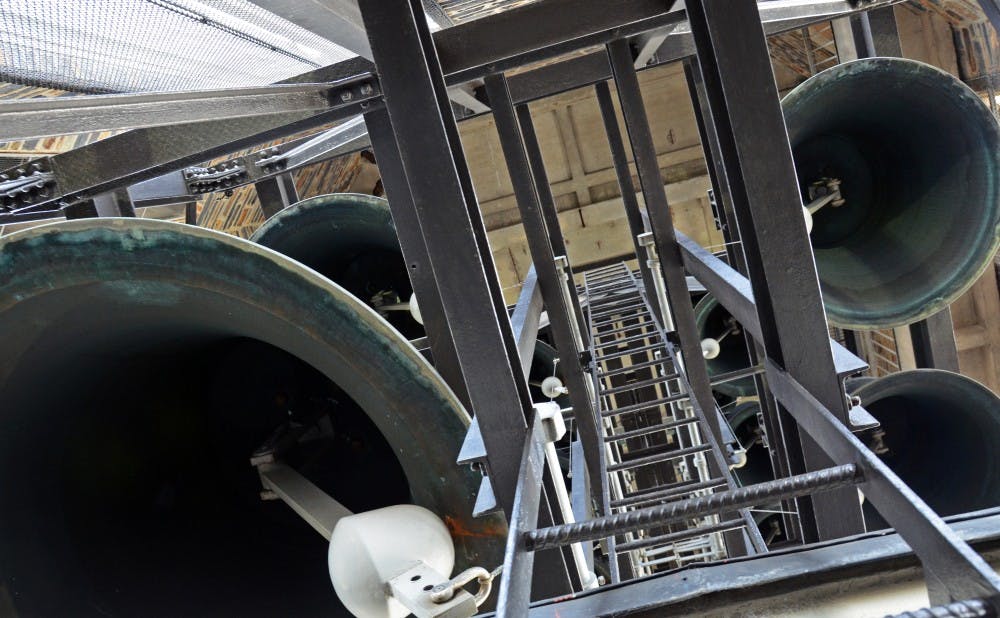University Carilloneur Sam Hammond began playing the Duke carillon in 1965, when he was an undergraduate at Duke. To this day, the Trinity ’68 grad continues to play the 50-bell carillon through rain or shine at 5 p.m. each day from the Chapel tower.
“I just didn’t have the decency to go away,” he joked.
Depending on his mood, Hammond, who is also Rare Book Librarian in Perkins Library, alternately performs austere Baroque compositions, lyrical hymns or adaptations of popular songs. The Harry Potter movie theme song remains a crowd favorite, he said.
I asked him what he would be playing for Halloween, just two days away.
“Well that’s a surprise! You’ll have to wait,” he chuckled.
Duke’s 50-bell carillon was cast in 1932 by John Taylor Bellfounders, Ltd., which has been in business since the 14th century. Each year, the foundry sends maintenance workers from England to perform a routine check-up on the iron bells.
Contrary to widespread belief, the bells do not swing upon being hit. Instead, they are bolted into place and hang ominously above a small, cabin-like room in which Hammond hits the 50 batons and 26 pedals that control one of the largest instruments at Duke.
The carillon looks like an oversized piano, with a horizontal series of oak batons arranged like the keys of a keyboard. When the batons are struck, they pull cables that, in turn, swing huge clappers that ring each of the bells. The largest bell weighs 5.5 tons, and Hammond has to put his entire body into the swing of his arm as he hits the corresponding baton. The result is a deep and ominous reverberation, a hum that seems to emanate from Chapel itself.
Inside the cabin, shelves of yellowed sheet music line the walls. The smell of old oak emanates from the two sets of wooden batons. One is for practice while the other is hitched up to the actual bells. The cabin is almost cozy. It is hard to believe that the bells we hear each day are played by a single man in such a small room.
Thunderstorms are one of Hammond's favorite times to play the carillon. The tower gets a little wet, he admitted, but he usually picks something dark and stormy to match the weather.
“Some people think it’s brave or foolish. It may be foolish, but it certainly isn’t brave,” he said.
At precisely 4:59 p.m., Hammond quickly changed his round, black frames for an identical pair of translucent red ones.
“Okay, here we go!” he exclaimed.
He sat relaxed at the wooden knobs of the carillon. With a quick intake of breath, he suddenly struck at the knobs. Hammond’s traditional, southern charm belied a surprisingly forceful style of playing. He sat relaxed at the wooden knobs of the carillon. With a quick intake of breath, he suddenly struck at the knobs. From my previous experience as a listener, I knew the notes were spilling out of the tower, to the far edges of campus for all to hear.
For the next 10 minutes, Hammond played as if in a trance, utterly absorbed in his music. His arms and legs moved in all directions at high speed, sometimes tenderly coaxing out sound, other times throwing his entire body into the notes. For several heart-stopping seconds, he remained frozen over the keyboard, arms raised dramatically, as the last notes bled out into silence.
Just as abruptly as the music began, Hammond was all business again. He put the sheet music away, gathered his belongings and shuffled out the door. Tomorrow at 5 p.m., he would be back again.
Get The Chronicle straight to your inbox
Signup for our weekly newsletter. Cancel at any time.

